Kerala Style Shrimp Pickle (Nadan Chemmeen Achar) is one of Kerala’s most loved non-veg pickles. Just a small spoon can turn plain rice and curry into a complete meal.
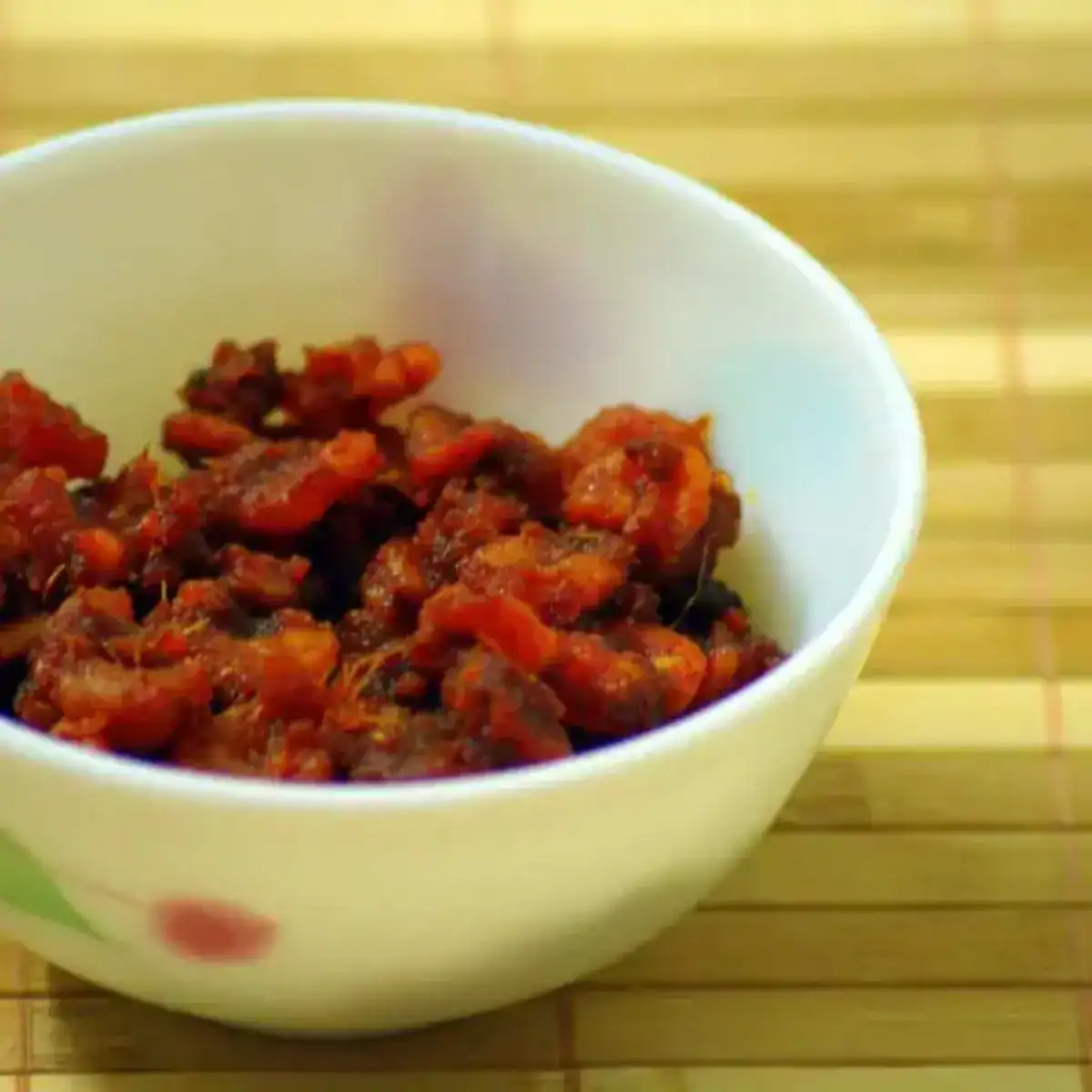
In Kerala, pickling is a common way to preserve seasonal ingredients. While raw mango and lemon are popular, seafood pickles like shrimp, mussels, and tuna are true local favourites.
Homemade versions are always more flavourful than store-bought. This recipe guide shares simple steps, tips, variations, and serving ideas to make it easily at home.
Jump to:
- What is Kerala Style Shrimp Pickle?
- Why You'll Love This Recipe?
- Recipe Ingredients
- Variations to Try
- How To Make Kerala Style Shrimp Pickle (Step-by-Step Guide)
- Tips And Tricks
- Serving Suggestions
- Storage Instructions
- Frequently Asked Questions (FAQ)
- More Kerala Style Shrimp Recipes To Try
- Kerala Style Shrimp Pickle
What is Kerala Style Shrimp Pickle?
Kerala Style Shrimp Pickle is a spicy pickle made with fried shrimp, garlic, ginger, spices, oil, and vinegar. The shrimp is first fried, then mixed with sautéed aromatics, ground spices, and vinegar for deep flavour and long shelf life.
In olden days, achar-making was a family tradition in Kerala homes. Grandmothers led the process, preparing large batches and storing them in airtight “bharanis”. These were then kept in cool, safe places like the ”pathayapura” to stay fresh for months.
Today, most people use clean glass jars and often store the pickle in the fridge for convenience.
In Kerala, both gingelly (sesame) oil and coconut oil are used. Gingelly oil is preferred for its strong flavour and preserving quality. In North India, mustard oil is common. In other South Indian states, groundnut oil is also used.
Globally, Indian pickles use oil as the main preservative. Western pickles rely on vinegar or brine. East Asian countries use fermentation techniques.
For another quick shrimp dish, check out our Kerala Style Shrimp Fry.
Why You'll Love This Recipe?
A spoonful brings the taste of Kerala to any meal. It’s easy to make and lasts for months. Every bite delivers deep, spicy, umami-rich flavour.
It also has a bold red colour from chilli and spices that makes it visually appealing and instantly appetising. You can serve it as a side with almost any dish.
Many NRIs carry it when flying back abroad, and travelers pack it for long journeys. It’s comfort, convenience, and Kerala in one small jar.
Recipe Ingredients
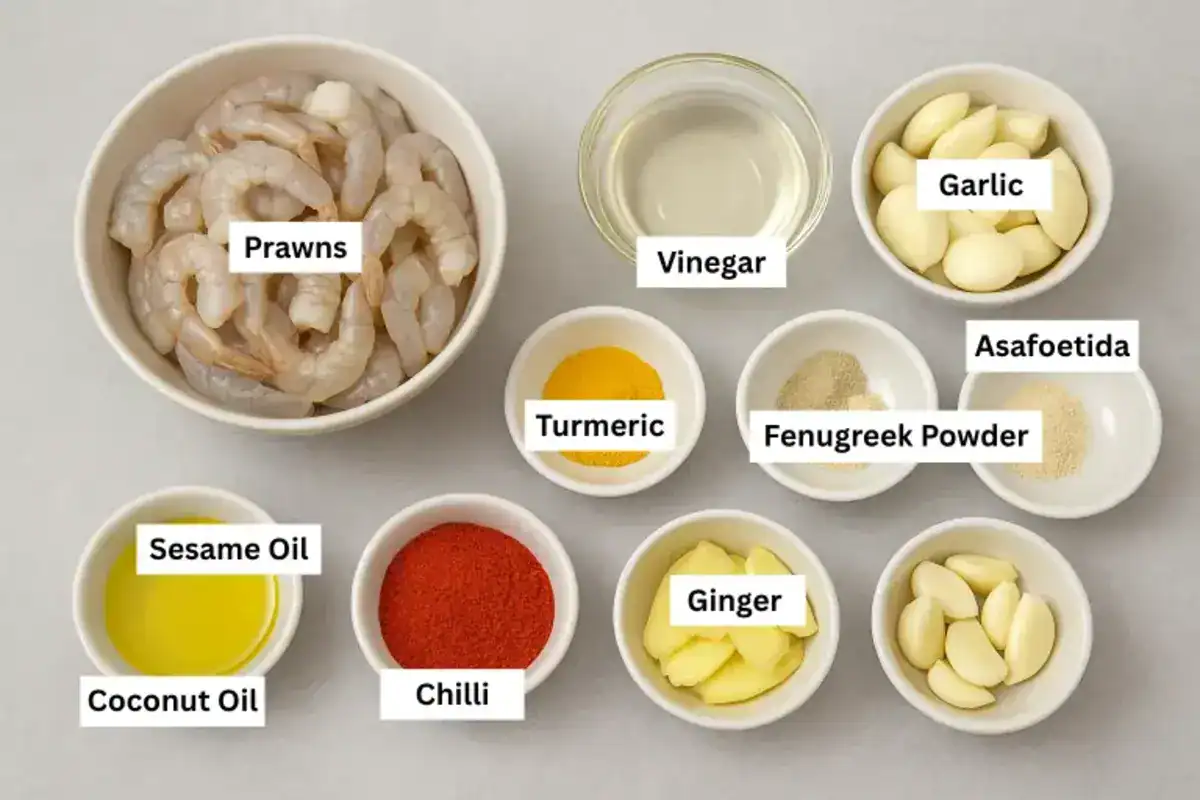
- Shrimp or Prawns (Konchu or Chemmeen)
Fresh is always preferred. Frozen works too. Small prawns are ideal for pickling because they absorb the masala better. - Sesame Oil (also known as Gingelly Oil)
This is the traditional oil used in pickles. It adds a strong aroma and acts as a natural preservative. Coconut oil can be used, but sesame oil offers better shelf life. More ingredients are given below. - Vinegar
Use only diluted vinegar. It adds tang and helps preserve the pickle. Always use non-reactive cookware. Some people skip vinegar, but it balances flavor and extends shelf life. - Asafoetida Powder
Optional ingredient. It adds mild depth to the flavor but can be skipped if not available. - Other ingredients
Ginger, garlic, turmeric, and chilli powder are also used. All measurements and nutrition values are shared in the recipe card below.
If you’re buying prawns for this pickle, keep some aside and try Spicy Nadan Konchu Masala Recipe. It’s a perfect side for rice or chapathi.
Variations to Try
If you don’t like vinegar, you can skip it and still make the pickle. Asafoetida is optional as well. For a stronger garlic flavour, add a few whole garlic cloves while sautéing.
This same base works well with mussels (kallumakkaya) or elambakka (clams). If you prefer a no-seafood version, just skip the protein. You’ll still get a quick, bold achar using the same spice mix.
Kerala also has many other traditional pickles like mango, lime, garlic, carrot, beetroot, dates, and mixed vegetable. Each has its own cooking method and unique flavour profile.
How To Make Kerala Style Shrimp Pickle (Step-by-Step Guide)
- Take the shrimps with shells, clean them well by removing the dirt, and remove all the water by draining well. Now add turmeric, Salt, a little bit of Kashmiri chilli powder and mix with a spoon. Marinate it for 10 minutes
- Keep it on a low flame and boil it. You will see the water from the shrimps oozing. Boil it till only a bit of water remains. Ensure it does not burn at all. This is important. So, for 1 Kg small shrimps, you will end up having only 200 gms after the boiling. They shrink during the process of boiling.
- Take the coconut oil & fry the shrimps till they are slightly golden brown. Do not over do this.
- Take the shrimps along with the oil. The oil will act as the preservative. Keep it aside
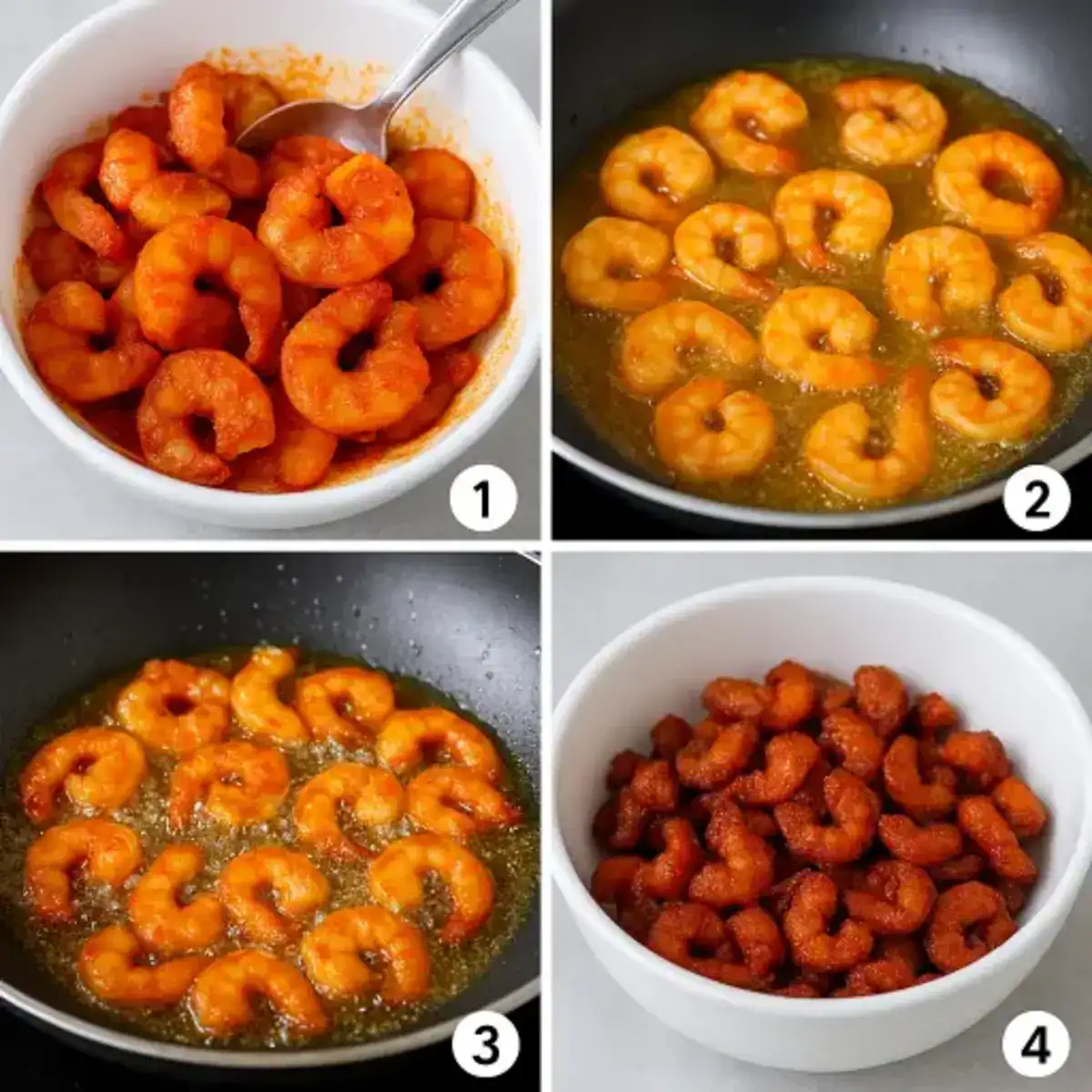
- Take garlic, ginger, and blend them into a semi-paste. not fully, but semi-paste
- Fry this ginger, garlic paste in sesame oil till golden brown.
- Switch off the flame. After 10-20 seconds, add the remaining Kashmiri chilli powder, Asafoetida powder, and fenugreek powder into this and mix very well in the pan till they look like a paste
- Add the shrimps plus the oil into this and mix. Taste occasionally and add more salt if needed.
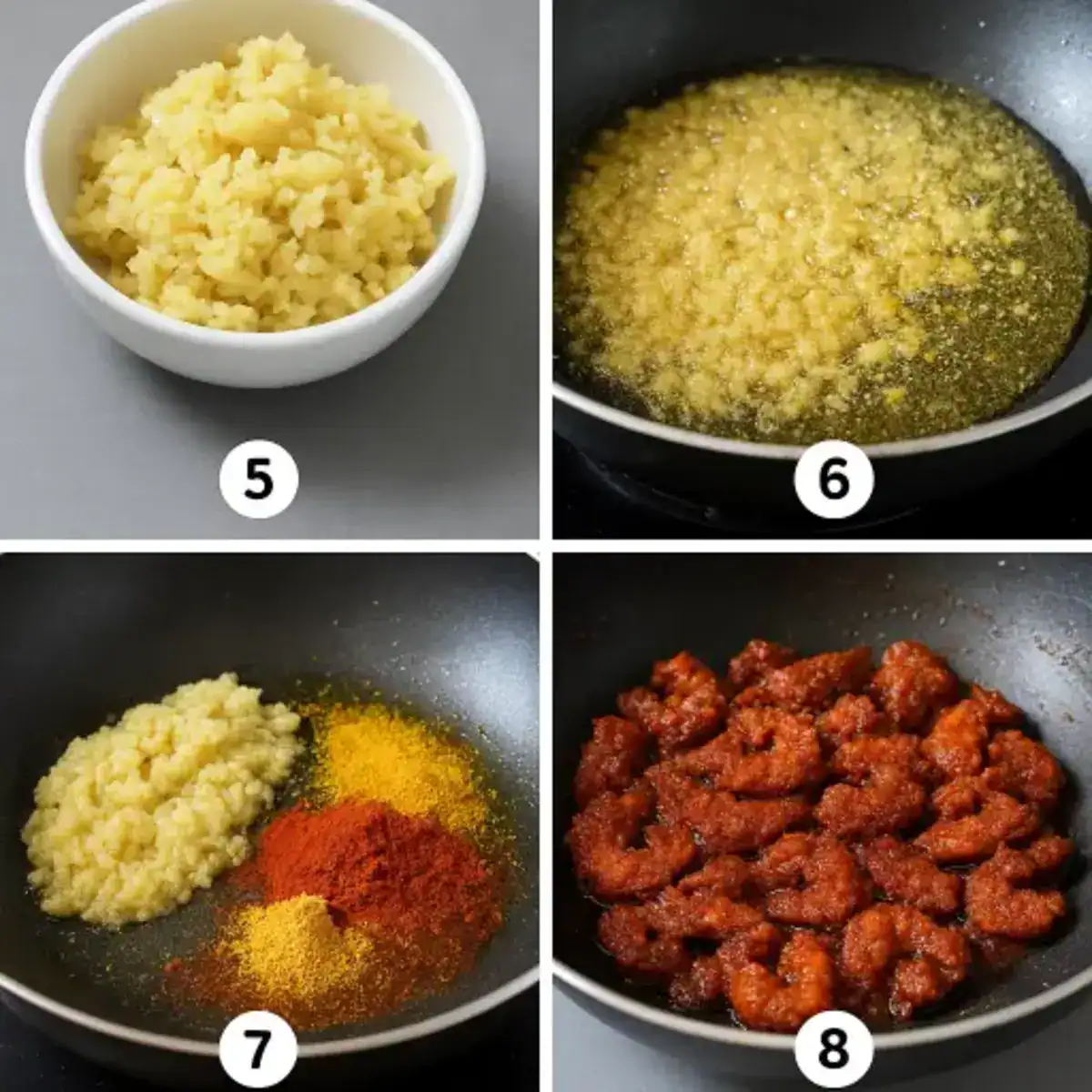
- Add vinegar to this little by little, tasting it now and then to see if it's not too sour. Vinegar concentration differs from places to place and hence the reason for not adding quantity.
- 10.Close this in a clean dry sterilized glass jar after cooling, and start using it after a day
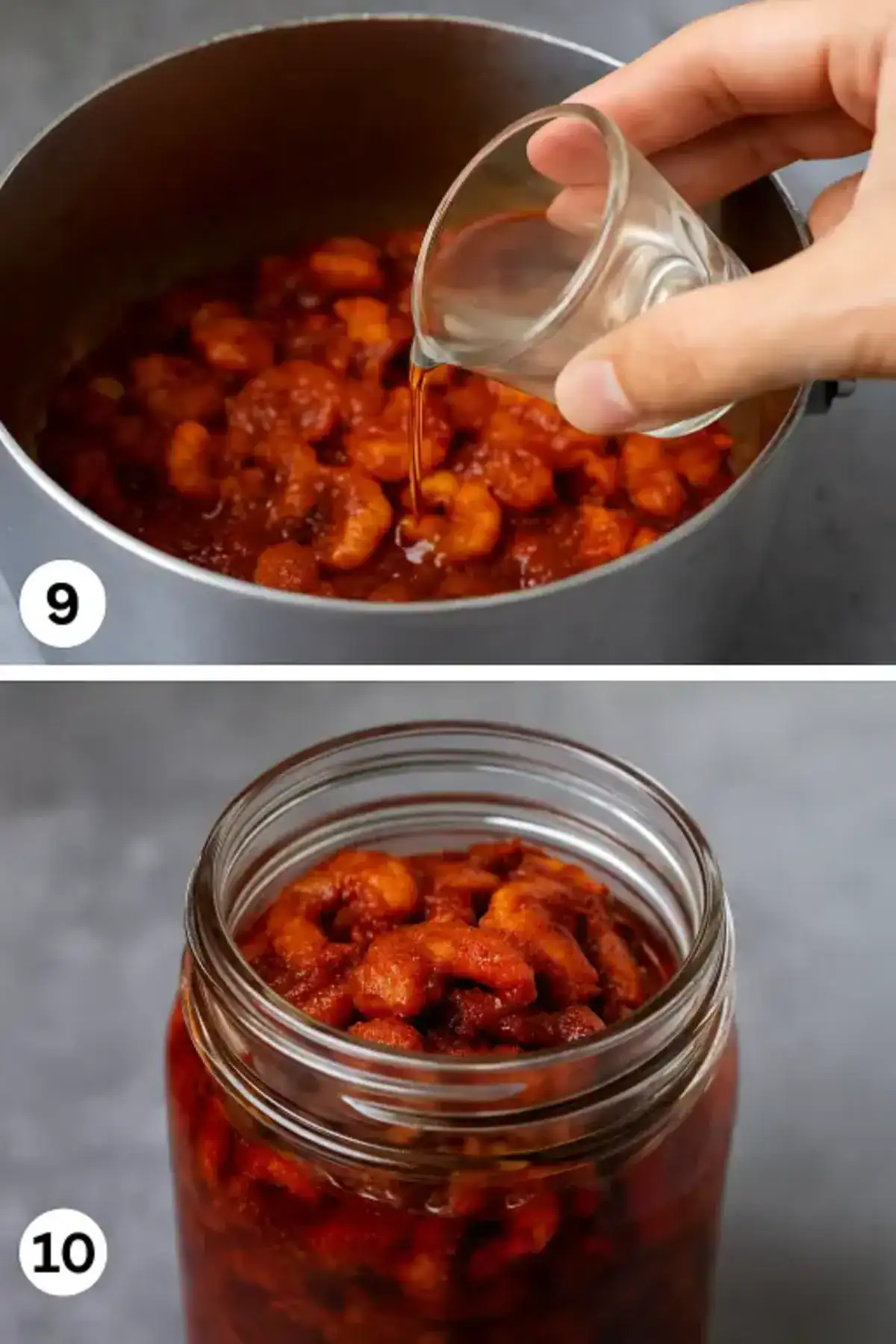
For a main dish idea using prawns, check out Varutharacha Chemeen Curry Recipe. It goes well with rice, pathiri, or even chapathi.
Tips And Tricks
- Use sesame (gingelly) oil instead of coconut oil for better flavour and longer shelf life.
- If adding vinegar, avoid aluminium or iron utensils. Always use steel or non-stick to prevent chemical reactions.
- When adding spices, switch off the heat or keep it low. Spices burn fast and can turn the taste bitter.
- Vegetarian pickles usually need weeks to mature, but seafood pickles like this can be used from the next day itself.
Serving Suggestions
Chemeen Achar pairs well with Kerala rice and ghee rice. You can also try it with Kerala-style fish biriyani if you like stronger sides with it. Many enjoy it as a breakfast side with Soft Steamed Puttu or pathiri. Some even have it with chapathi and kuboos.
It also takes pazham kanji (fermented rice porridge) to a taste level that’s hard to describe. Bold, comforting, and unforgettable.
Storage Instructions
Storage is very important for Kerala Style Shrimp Pickle. While cooking, make sure no water touches the achar. Once it’s done, let it cool down completely before storing.
Always sterilise the jar before use. Glass jars are preferred. Make sure the jar is fully dry with no trace of water.
Store the jars in a cool, dry place.Storing in the refrigerator helps extend its shelf life.
Try to keep a layer of oil on top at all times. Always use a dry spoon to take the pickle out. Even a little moisture can spoil the achar or cause mould to form.
The shelf life depends on how well you store it, the climate, and the quality of ingredients used.
While this pickle stays for months, dry dishes like Kerala Style Prawns Roast are best enjoyed fresh within a day or two.
Frequently Asked Questions (FAQ)
Yes, you can eat it right after making it. But the flavour will be sharper and less balanced. Once it matures over a few days, the true umami and depth of taste come through.
Yes, it's normal. The sharpness reduces as the spices blend and settle. The taste improves as the pickle matures.
More Kerala Style Shrimp Recipes To Try
I’d love to hear your thoughts if you have tried this! Please leave a ⭐️ rating and a comment below. Don’t forget to share your photos on Instagram and tag @a_little_bit_of_spice.
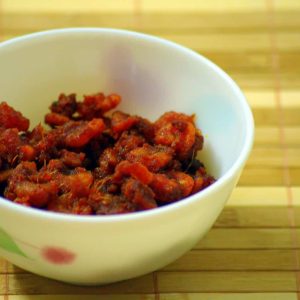
Kerala Style Shrimp Pickle
Ingredients
- 1 Kilo shrimps with shells
- 2 Grams turmeric
- Salt
- 30 Grams Coconut Oil
- 60 Grams sesame oil
- 25 Grams garlic , cleaned
- 25 Grams ginger , cleaned
- 20 Grams kashmiri Chilli Powder
- 1 Gram Asafoetida
- ½ Gram fenugreek powder
- vinegar , diluted
Instructions
- Take the shrimps with shells, clean it well by removing the dirt and remove all the water by draining well. Now add turmeric, Salt, little bit of kashmiri chilli powder and mix with a spoon.
- Marinate it for 10 minutes
- Keep it in low flame and boil it. you will see the water from shrimps oozing. Boil it till only a bit of water remain. Ensure it does not burn at all. This is important.
- So for 1 Kg small shrimps, you will end up having only 200 gms after the boiling. They shrink during the process of boiling.
- Take the coconut oil & fry the shrimps till they are slightly golden brown. Do not over do this.
- Take the shrimps along with the oil. The oil will act as the preservative.Keep it aside
- Take garlic, ginger and blend it to a semi paste. not fully, but semi paste
- Fry this ginger,garlic paste in sesame oil till golden brown.
- Switch off the flame. after 10-20 seconds add the remaining kashmiri chilli powder, Asafoetida powder, fenugreek powder into this and mix very well in the pan till they look like a paste
- Add the shrimps plus the oil into this and mix. Taste occasionally and add more salt if needed.
- Add vinegar to this little by little, tasting it every now and then to see if its not too sour. Vinegar concentration differs from places to place and hence the reason for not adding quantity.
- Close this in a bottle after cooling and start using it after a day
Notes
- Use sesame (gingelly) oil instead of coconut oil for better flavour and longer shelf life.
- If adding vinegar, avoid aluminium or iron utensils. Always use steel or non-stick to prevent chemical reactions.
- When adding spices, switch off the heat or keep it low. Spices burn fast and can turn the taste bitter.
- Vegetarian pickles usually need weeks to mature, but seafood pickles like this can be used from the next day itself.
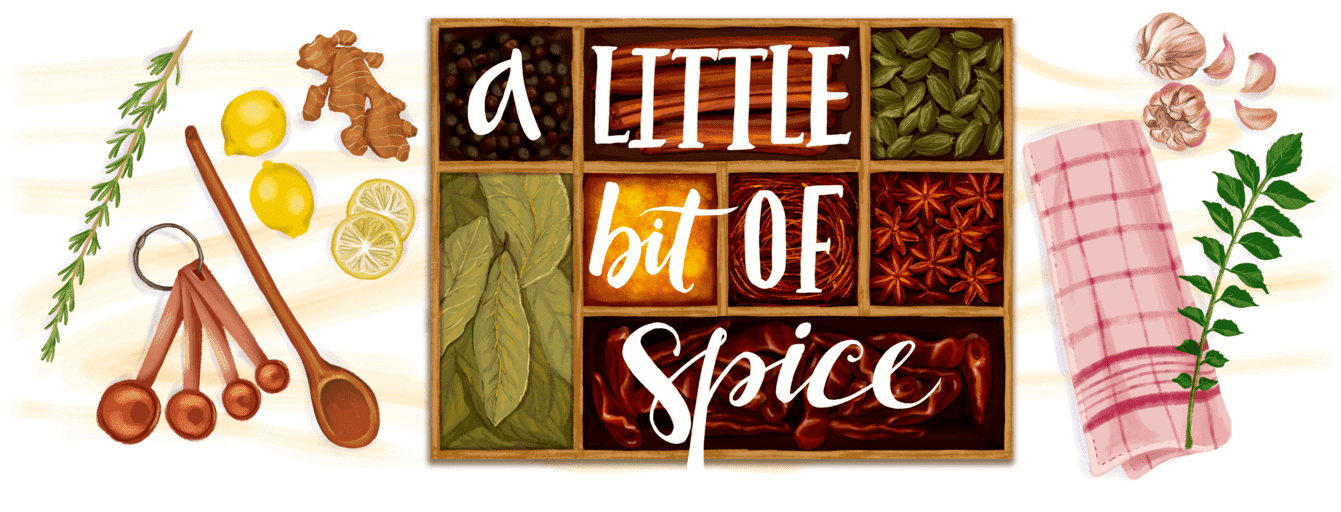

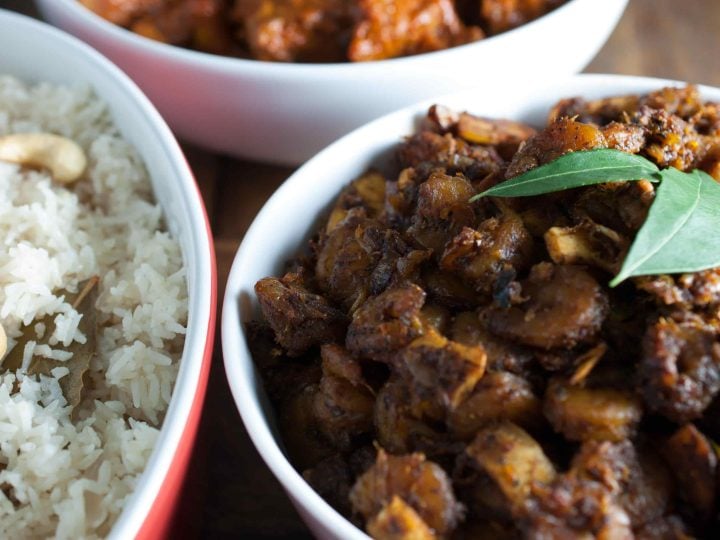
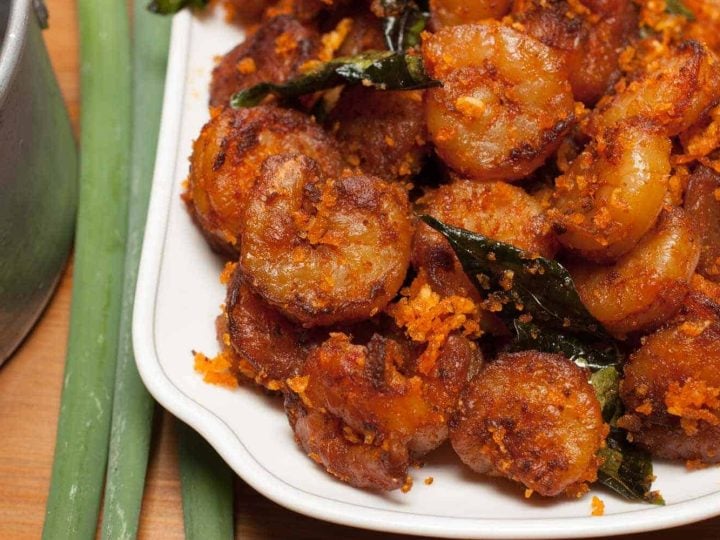
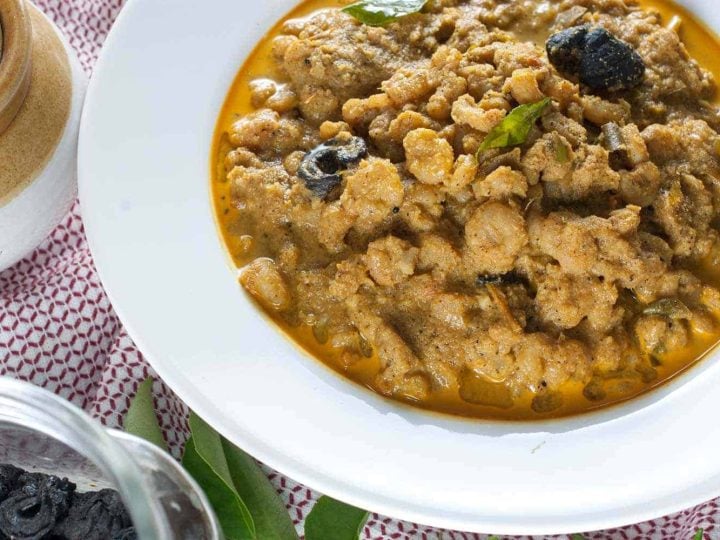
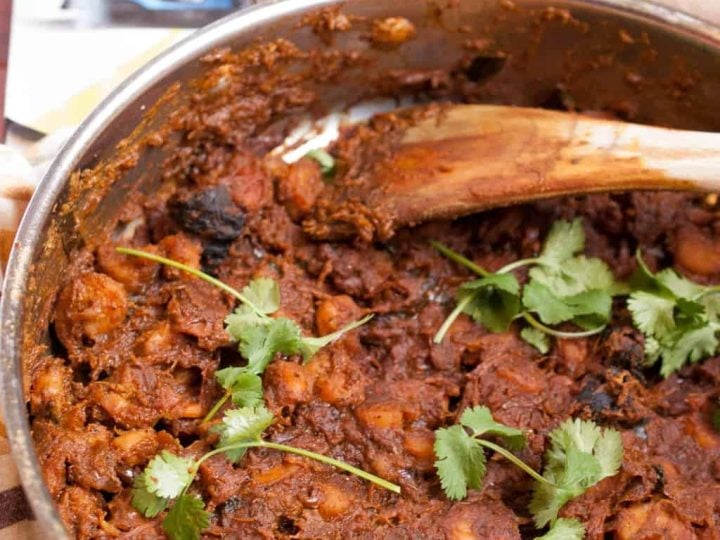
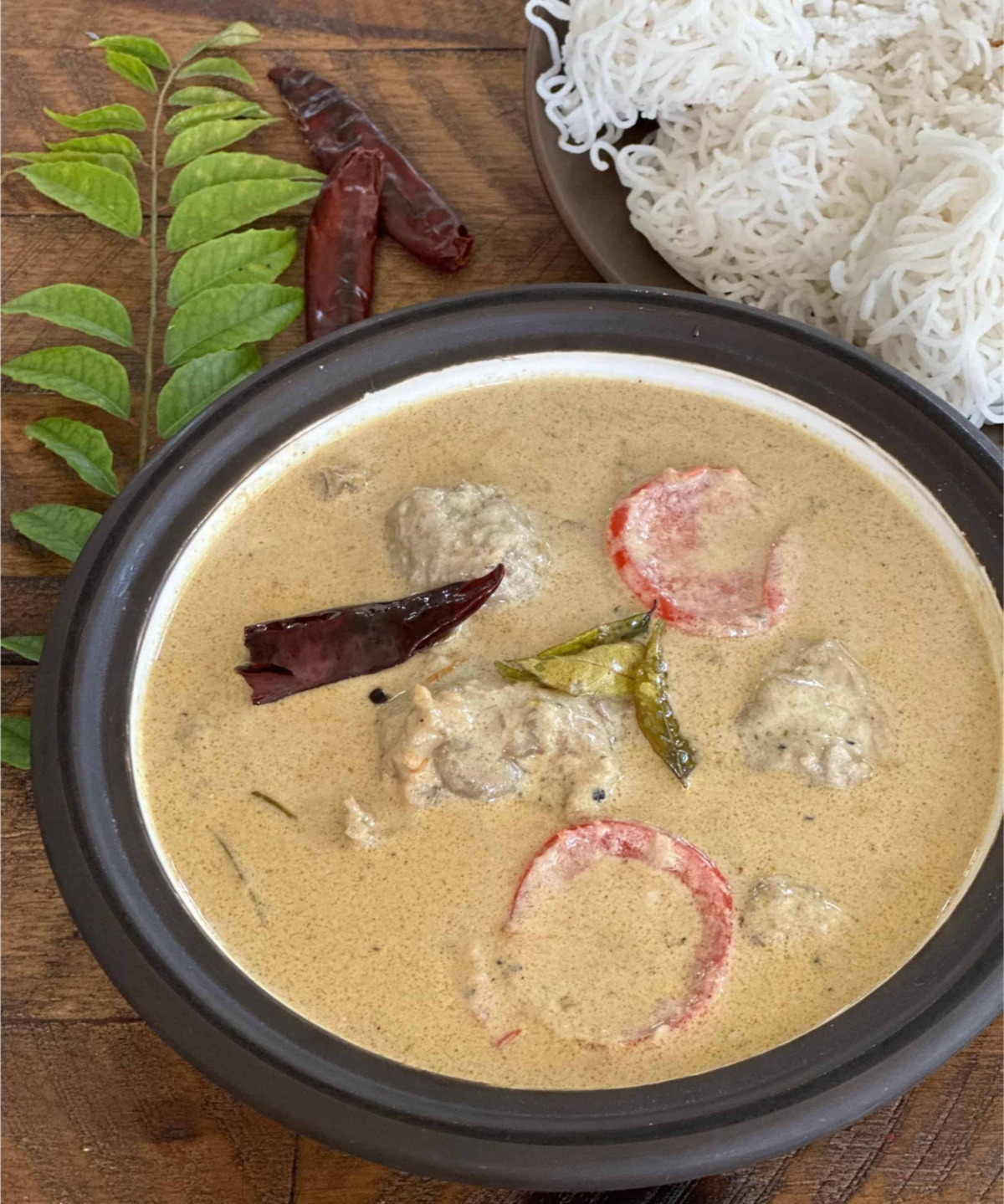
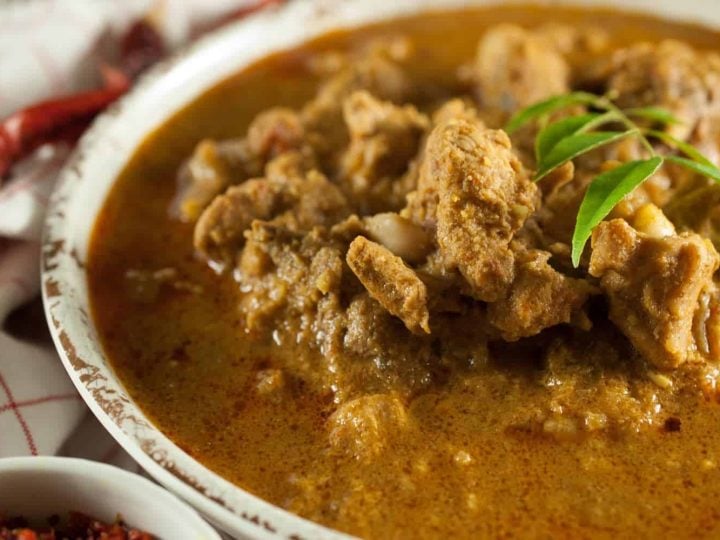
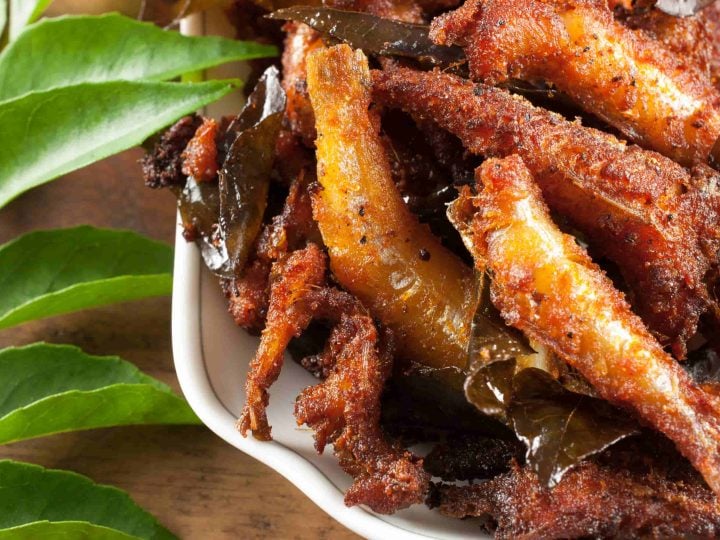
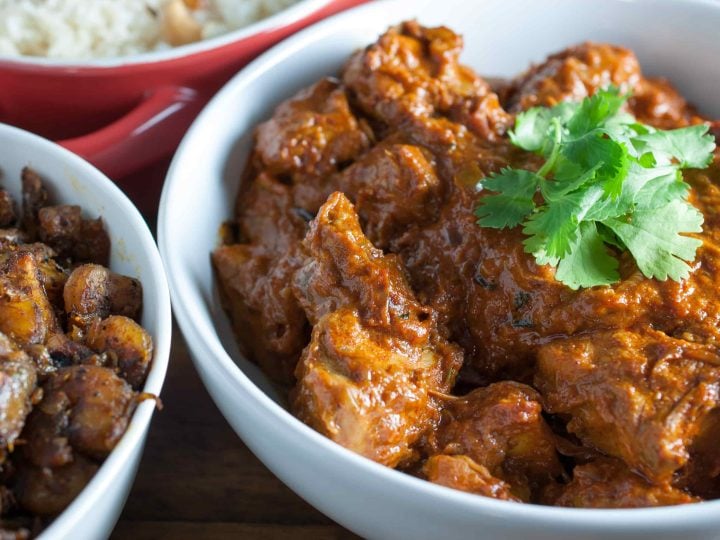
didnt think it cud be this simple... will definitely try!